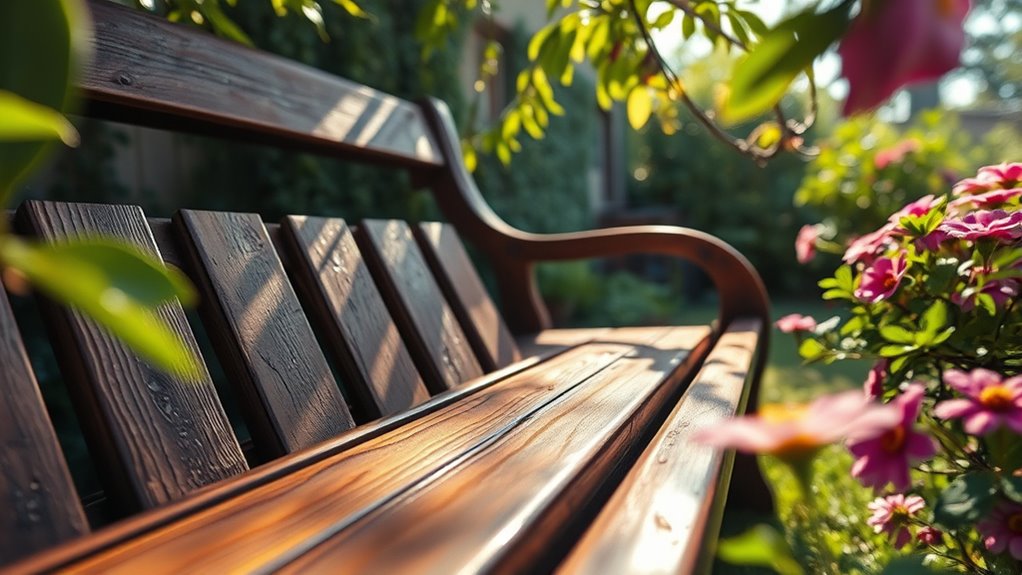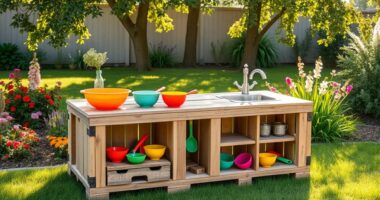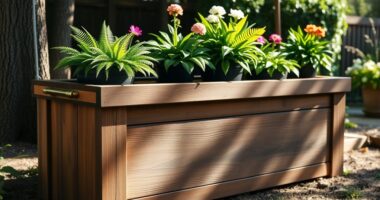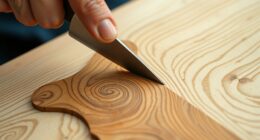To weather-proof your garden bench, start by thoroughly cleaning and sanding it to create a smooth surface. Apply a natural oil or wax for a matte finish or a synthetic sealant like polyurethane for extra water resistance. Be sure to cover all surfaces, including underneath and legs. Regularly inspect and reapply the protective finish as needed to keep your bench looking great and lasting longer. Keep going to discover more expert tips!
Key Takeaways
- Thoroughly clean and sand the bench to prepare a smooth surface for sealing.
- Choose between natural oil/wax or synthetic sealants based on desired durability and finish.
- Apply the sealant evenly, ensuring all surfaces, including undersides and legs, are fully coated.
- Reapply sealant regularly after inspecting for wear, cleaning, and light sanding to maintain weather resistance.
- Proper sealing enhances the bench’s longevity, appearance, and protection against moisture, rain, and snow.
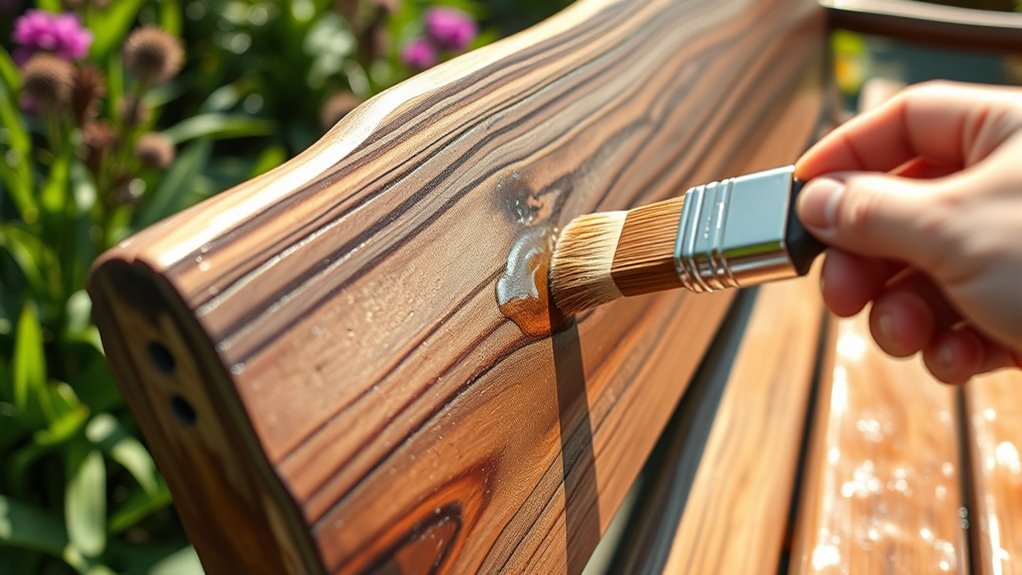
A garden bench can transform your outdoor space, but it’s essential to safeguard it from weather damage to guarantee it lasts for years. One of the first decisions you’ll face is choosing the right type of wood or finish. When comparing teak vs. cedar, consider their natural properties. Teak is dense and contains natural oils that resist water and pests, making it highly durable for outdoor use. Cedar, on the other hand, is lightweight and has a pleasant aroma, but it’s less dense and can be more susceptible to moisture and decay over time. If you prefer low-maintenance, teak’s natural resistance might be more appealing. However, cedar’s softer texture makes it easier to work with and often more affordable.
Choosing between teak and cedar depends on your durability and maintenance preferences.
Once you’ve selected the wood, the next step is deciding between natural vs. synthetic finishes. Natural finishes, like oil or wax, penetrate the wood and enhance its natural grain, providing a subtle, matte look. They’re easy to apply and can be refreshed regularly, but they may require more frequent reapplication to maintain protection. Synthetic finishes, such as polyurethane or marine-grade sealants, create a hard, protective layer on the surface. These finishes often offer superior water resistance and durability, especially against harsh weather. They also provide a glossy or semi-gloss appearance that can make your bench look polished and new longer.
Applying the appropriate wood sealing techniques ensures optimal weatherproofing and longevity of your garden bench. To weather-proof your bench properly, start by cleaning the wood thoroughly, removing dirt, mold, and old finishes. Sand down any rough patches and uneven surfaces to ensure an even application of your chosen sealant. If you’re using a natural finish like oil, apply it generously with a brush or cloth, working it into the grain. For synthetic coatings, use a high-quality brush or spray to achieve a smooth, even layer. Make sure to cover all surfaces, including the underside and legs, where moisture can seep in.
Reapplying your finish periodically is key to maintaining weather resistance. Check your bench regularly for signs of wear or damage. If you notice peeling or dullness, sand lightly and reapply your sealant to restore protection. Proper sealing not only prolongs your bench’s lifespan but also keeps it looking beautiful through seasons of sun, rain, and snow. By choosing the right wood, applying suitable finishes, and maintaining them, you’ll enjoy a sturdy, weatherproof garden bench for many years to come.
Frequently Asked Questions
How Often Should I Reseal My Garden Bench?
You should reseal your garden bench every 1 to 2 years to maintain its protection. DIY alternatives like natural oils can extend sealant longevity, but may need more frequent reapplication. Regular resealing helps prevent water damage, cracking, and rot. Keep an eye on your bench’s condition; if you notice water soaking in or the finish wearing thin, it’s time for another coat. Proper maintenance guarantees your bench stays durable and looks great.
Can I Use Homemade Sealants Instead of Commercial Products?
You might wonder if DIY alternatives or natural sealants can replace commercial products. While natural sealants like beeswax or tung oil can offer some protection, they often don’t provide the same durability and water resistance as professional sealants. If you prefer eco-friendly options, make sure you apply them thoroughly and reapply more frequently. However, for long-lasting weather-proofing, commercial products typically deliver more reliable, consistent results.
Will Sealing Affect the Bench’s Appearance or Color?
Sealing your garden bench won’t ruin its appearance; in fact, it helps with color preservation and enhances the finish. You might notice a slight change in sheen, but quality sealants are designed to protect without dulling or darkening the wood excessively. If you choose a clear or matte finish, your bench’s natural beauty remains visible, maintaining its original look while offering better protection against weathering.
Is Sealing Necessary for All Types of Wood?
Think of sealing as giving your wood a suit of armor. It’s not necessary for all wood types, but it’s highly recommended for outdoor furniture. Different wood types respond uniquely; softer woods need sealing to prevent damage, while some hardwoods resist weathering naturally. The sealing benefits include increased durability and protection from moisture. So, assess your wood type to decide if sealing will keep your bench looking its best for years to come.
What Are the Environmental Impacts of Wood Sealants?
You wonder about the environmental impacts of wood sealants. Using eco-friendly ingredients reduces pollution and minimizes harm to ecosystems. These sealants often contain less toxic chemicals, helping you protect the environment while maintaining your garden bench. By choosing environmentally conscious options, you contribute to pollution reduction and promote sustainability. It’s a smart way to keep your outdoor furniture durable without compromising ecological health.
Conclusion
By sealing your garden bench properly, you’ll protect it from rain, sun, and snow, ensuring it lasts for years. Imagine spending a sunny afternoon relaxing on your newly sealed bench, confident it’ll stay beautiful despite the weather. For example, Jane sealed her wooden bench last spring, and now, after a harsh winter, it looks just as good as day one. Take these steps today, and enjoy a durable, weather-resistant spot to unwind for seasons to come.
